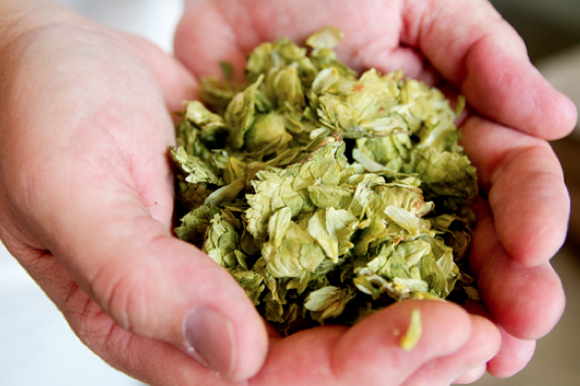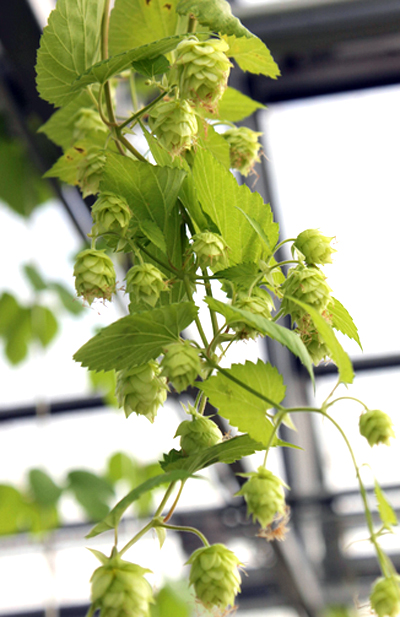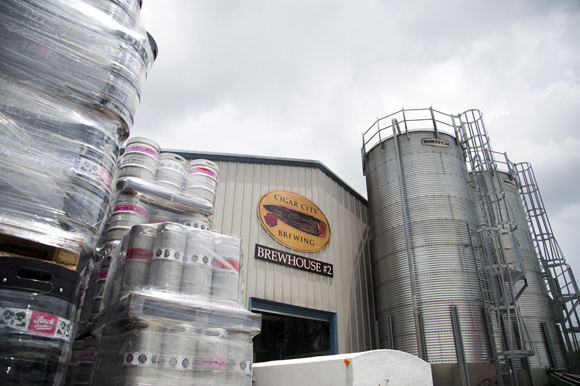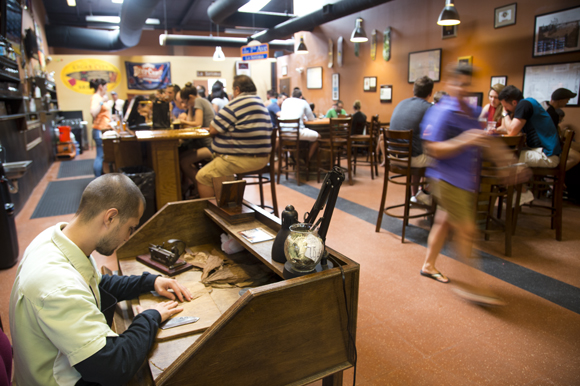Local craft beer industry, scientific passion fuel growth of Florida hops
As experiments to grow hops in Florida find success, demand created by the growing local brew scene may prove to be a boon to the state’s struggling citrus growers.
They said it couldn’t be done: Hops could not be grown in Florida.
The state’s abundant heat, bugs and proximity to the equator made the cultivation of the hop plant, Humulus lupulus , out of the question.
Everybody knew that.
But horticulturist and hobby beer crafter Brian Pearson knew better, because he’d already done it — quietly and without fanfare on a tiny patch of dirt at the University of Florida’s Apopka research center.
Later it would be considered something of a scientific breakthrough. But that’s not exactly what Pearson had in mind at the time.
“The biggest thing for me personally was to have a Florida-hopped beer,” he says.
The timing couldn’t have been better.
While Pearson was keen on brewing a Florida-centric beer, local growers were looking for a new niche crop to supplement dwindling citrus production.
Meantime, the state’s home-grown craft beer breweries were bubbling up at a phenomenal rate and Florida-grown hops offered brewmasters an opportunity to stamp their product with a unique local flavor.
That would be a boon to local breweries, says Simon Bollin, Hillsborough County’s Agribusiness Industry Development manager.
“Typically the consumer of craft beer tends to be someone who likes to eat and drink locally; it’s a main theme in the industry,” says Bollin, who was instrumental in getting the Florida hops project off the ground.
Quest for terroir
Consumers’ hunger and thirst for non-corporate, locally sourced food and drink has driven the eat-and-drink-local phenomenon that has accompanied the breathtaking rise of craft breweries across the state and across the nation.
Florida went from 50 breweries to more than 150 between 2011 and 2015, the last year tallied by the national Brewers Association.
More breweries opened in Florida last year than in any other state.
Local ingredients and exotic flavor combos like oatmeal raisin cookie and chocolate peanut butter stout are the foundation of neighborhood brewpubs and taprooms where aficionados flock to quaff their favorite hops-based elixir.
Geography is essential to the character of hops, which imparts a citric bitterness to beer that is regionally distinct, depending on where the plants are grown.
“For us, it would be really exciting to be able to have local-grown hops. We kind of thought it would be impossible to get it,” says Justin Clark, COO for Cigar City Brewing, one of the oldest Tampa breweries and, along with Coppertail Brewing and Six Ten Brewing, was among the first to embrace the Florida hops project.
Local brewers offered input into preferred hop varietals that might be tested, and also supported securing the grant with assurances of a commercial market for the crop.
Aside from being able to add a fresh key ingredient to the hyper-localized craft beer industry, Florida hops could offer a distinct new flavor due to a phenomenon called terroir — where environmental factors like soil, air, water and climate combine to infuse artisanal crops like grapes or agave with a unique character.
The question was, could this indispensable hop plant — the foundation for creating the world’s most popular alcoholic beverage — be grown in sufficient quantities to support commercial production and feed the state’s burgeoning craft beer industry?
That’s what researchers at UF’s Institute of Food and Agricultural Sciences (IFAS) aim to discover with a $158,000 grant and a few choice acres in Wimauma and Apopka — where latitudes and climate diverge wildly from hops’ typical growing grounds in the Pacific Northwest.
Growers hop on hops project
The flowers of the hop plant are generally shipped in dried or pellet form from Oregon and Washington state.
On the other side of the country, UF’s Pearson wanted something more for his own home brew. He yearned for what he calls “the crème de la crème” — wet-hopped beer — and for that he would need fresh hops.
The only way to get that was to grow it himself. “I figured: I’m a horticulturist, so why not give it a shot?”
Pearson’s quest began in 2012, when he used his own seed money, so to speak, to spring for a handful of rhizomes that, remarkably, turned into a healthy little crop of hops.
“It blew all expectations out of the water that I had for them,” he says.
Yes, it could be done. But was there a market for Florida hops?
Pearson figured other craft beer hobbyists might be interested in growing their own backyard hops, so he wrote a paper geared toward them and put it on the IFAS website.
“What came was an overwhelming response,” he said.
Not from backyard hobbyists, but from commercial citrus growers looking for alternative crops to expand and diversify their production.
Growers have been hit hard in recent years by plant diseases, like citrus greening, which have cut into crop yield and cast a long shadow over the future of Florida’s leading agricultural commodity.
Enter Bollin, who brought growers and brewers and researchers together to explore the possibilities.
Seeing the explosive growth of craft beer in Hillsborough alone, he was quick to grasp how it might energize Florida agriculture and help subsidize King Citrus.
“A Cascade hop from Oregon will taste different from a Cascade hop grown in Florida,” says Bollin. “The brewers were very interested.”
Promising results
Of some 100 hops varieties, Cascade is by far the most widely used in brewing craft beer — and the one that has, so far, shown the most promise in the Florida trials, says UF’s Zhanao Deng, lead researcher on the Florida hops project.
Deng came to Pearson nearly two years ago to express interest in trying his hand at hops at UF’s Gulf Coast Research Center in Wimauma.
While Pearson continues experimenting with four varieties of hop plants in Apopka, Deng and fellow UF researcher Shinsuke Agehara have been nurturing and assessing a dozen or more in Hillsborough County.
An early winter trial with a few plants in a greenhouse proved somewhat disappointing, he said.
But the spring crop planted in an acre of ground in Wimauma started producing hops cones in early June and the harvest goes on.
There are 40 20-foot telephone poles in Deng’s hops yard and the vines were expected to reach the top; but only a few of them realized their potential.
The plants are much shorter than in Oregon and Washington State,” says Deng. “They can produce some cones, but not as much as we want.”
What’s missing is hours of daylight, he says.
Hillsborough County sees 13 hours of daylight, while plants grown in the Pacific Northwest get 16 to 17 hours. Hop plants need at least 15 to produce a good commercial crop.
The Wimauma researchers plan to add artificial lighting to their field to give the plants another three or four hours.
“That’s something the hop growers in South Africa have done and it was very good,” he said.
There are also new varieties of plants being bred that don’t require as much exposure to daylight, so that’s another option they might try, Deng adds.
The state block grant, made possible by the Florida Specialty Crop Foundation, is only good for two years.
“Ideally we would like to test five years or longer,” says Deng.
It is still too early to know whether their efforts will yield a commercially viable crop, but Pearson — now in his third year of growing hops — is optimistic.
He was especially excited to discover that the plants he was growing in Apopka contained twice the amount of essential oils as the hops imported from the Northwest.
“They have a much stronger aroma and flavor — much stronger,” he says. “That adds a whole new dimension to the agricultural sector, the brewers and consumers.
Just why Florida’s hops are twice as aromatic and flavorful is not clear, but it is definitely related to an environmental influence, perhaps a stress response, says Pearson.
The hops cone that’s used by brewers is the female flower of the plant, like the cannabis flower of the marijuana plant, its closest cousin.
“The hop plant could be exuding extra compounds to protect itself or enhance its ability to reproduce,” he says.
In any case, time will tell whether Florida hops will figure at all in the state’s agricultural future, or might even open a whole new world for local brewers and beer-lovers.
Interest in the project from around the state, and from other states interested in feeding their own craft beer breweries, continues to grow.
“With the grant, it caught fire. Very rarely a day goes by that I don’t hear about it,” Pearson says.
Just this summer the Florida Hops Consortium was launched to bring brewers and growers together on Facebook.
Meantime, Pearson can’t believe he gets paid to do beer research.
“I never thought in a million years that I would be doing work on hops and beer,” he says. “It’s been exciting to work with the brewers and exciting to help launch new ag products at a time when growers need it.”
Then, there’s another bonus coming to the office these days.
“It smells so good. Like fresh beer.”
Jan Hollingsworth has been reporting on Florida’s agriculture industry since the 1990s. Comments? Contact 83 Degrees.





















